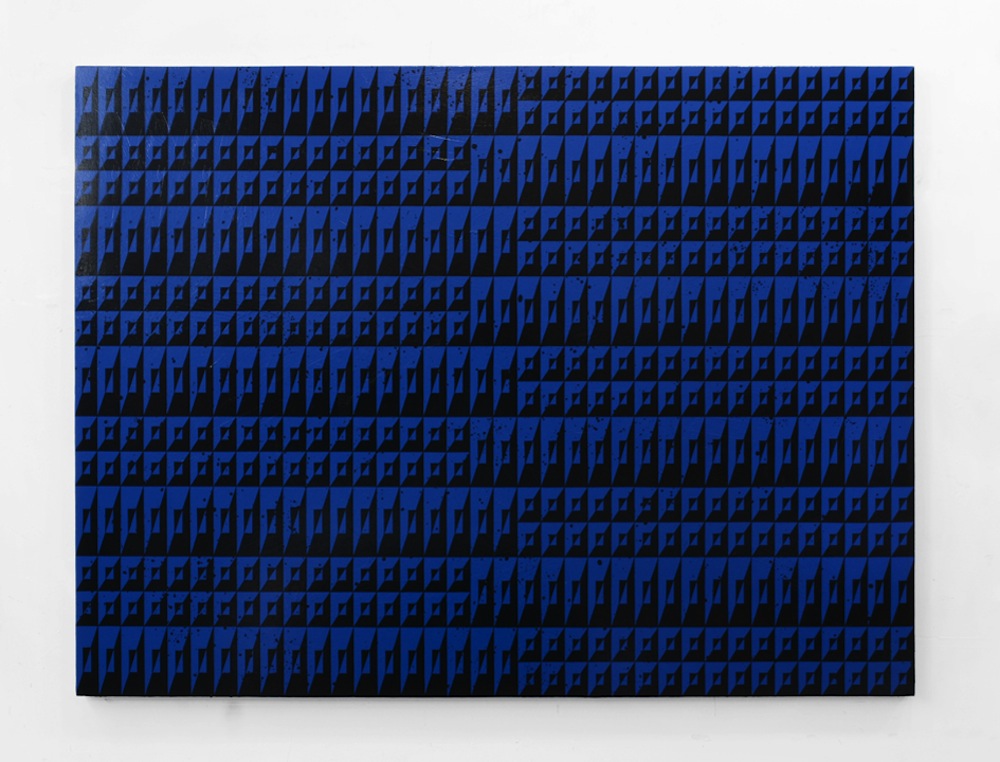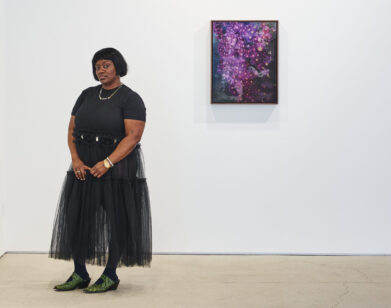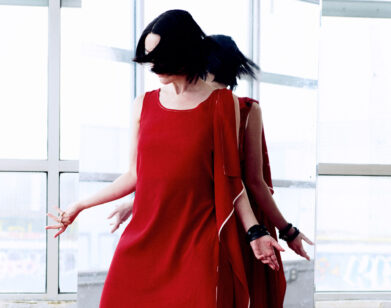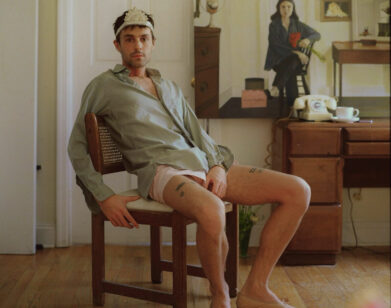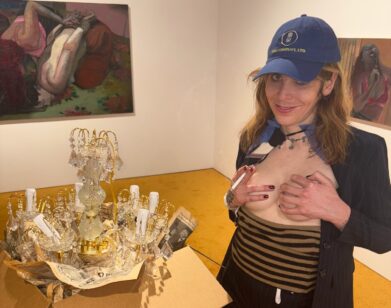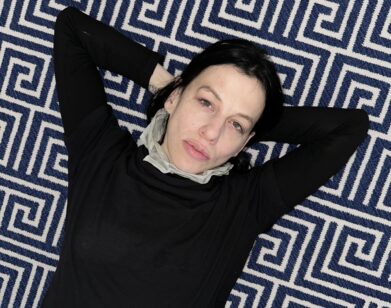Artists at Work: Matt Mignanelli
MATT MIGNANELLI AT HIS STUDIO IN BROOKLYN, NEW YORK, JUNE 2016. PHOTOS: CHRISTIAN HOGSTEDT.
This summer, during group shows and ahead of fall exhibition openings, we’re visiting New York-based artists in their studios.
Using acrylic and enamel paints, artist Matt Mignanelli freehandedly creates graphic, abstract paintings that transform upon every glance. Physically moving around a black-on-black painting of a cubic grid will reveal layers of optical illusions, while simply blinking when standing in front of a canvas covered in a complex navy-and-white pattern tricks the eye into seeing an oscillating, three-dimensional piece of art. Each piece of Mignanelli’s work depicts polygons of various shapes and sizes (with only the slightest occasional curve), yet they also always finds their roots in reality—most frequently architecture and light.
“I’ve always had a fascination with things that are utilitarian, stripped down, and pared down,” Mignanelli says when we meet at his Bushwick, Brooklyn studio.
Walking into his studio, canvases bearing navy and black hang on one wall opposite three other works composed entirely of navy and white. The table on which he paints stands in the middle of the room; a rack for drying, storage space, and a sink are flesh against the back wall; and windows line the front. Standing in the center, turning from one set of canvases to the other creates an immediate juxtaposition, the shade of navy appearing strikingly different even though it is the exact same paint.
During his studies at Rhode Island School of Design in Providence (the same town where he grew up), Mignanelli often made “cartoon-ish, but flat” paintings. He has always painted with a very hard edge, and with very flat colors, but after graduation and moving to New York, he gradually began eschewing both form and color, aside from black and white. Mignanelli only reintroduced color to his practice earlier this year, prior to participating in a group show at The Hole in New York. This summer, however, his minimally colored work will appear in two more group shows: “Sequenced Perceptions,” which opens today at Galerie Clemens Gunzer in Zurich, and another opening later this month at Hollis Taggart in Chelsea.
EMILY MCDERMOTT: You’ve being working on this series for about five years, but just recently introduced the color blue. What led to that shift?
MATT MIGNANELLI: The show at The Hole at beginning of this year was the first time I showed the starker, colored works. I used to make colorful work and I decided to come back to it. My daughter was just born last summer and it changed [me]. We were up at all hours of the night, we left the city for a bit, we were out at the beach—those blues in the night sky and the morning sunrise played into my psyche. I thought it was natural transition from black and white to the dark blues. It didn’t feel like too large of a shift.
MCDERMOTT: Speaking of the beach, color aside, you can also see a wavelike shape and motion in the new canvases. The way you incorporate a slight wave changes the entire optic scope.
MIGNANELLI: Yeah, that’s been my ethos as I shift—minor tweaks that create a whole new body of work. Before, when I was making the black-on-black work, I shifted sizes [of canvases]. By changing the orientation of the work, it created a whole new experience using the same tools. That was really exciting. Using the different shapes within the same canvas has been the new shift. It creates movement and swirl.
MCDERMOTT: You’ve purposefully allowed background drips to remain visible in previous works, so what about the splatters seen in the new works?
MIGNANELLI: The earliest works were perfectly pristine—the surfaces were wet-sanded—but then I started hanging them vertically and priming them, so whatever was happening happened. With these, everything is painted flat on the table, so I allowed the paint as it moves around the canvas to come through more. They only take one coat of the dark color over the white, whereas before it was a laborious process of about five coats in each area.
So the newer works allowed me to speed up, which allowed a humanity to come through, and I like that. It feels good leaving the physical test, the endurance test, that was so present in the previous work. But it’s always been important for me that the hand came through because they’ve never been taped. This is the new iteration.
MCDERMOTT: I’m still amazed that they’re all freehand. When I first read that fact, I was so surprised. I read that you do map it out beforehand with rulers and pencils, at least.
MIGNANELLI: Yeah, although the interior triangles are entirely freehanded now. But not for any reason other than speed. Before I would measure it all out, but the framing rectangles are already there. I wanted the color scheme to stay in the industrial mode. Going into it, putting premixed navy on white looked black. It was a new process to figure out how to make it look blue.
MCDERMOTT: So going back to the very beginning, what drew you toward architecture as a source of inspiration?
MIGNANELLI: In the earlier works, it was a 50/50 split between architecture and abstraction. It created this solidity and was grounded in a certain space, but the area left open allowed you to drift. They started becoming this all-encompassing environment, but being in the city and looking around and drawing and the way the harsh light hit certain areas started to interest me. I like to make abstract works, but they’re always based in reality. I need that jumping off point.
MCDERMOTT: You’ve said in other interviews that you started painting at a young age, but how did you first become interested in art? Did your parents cultivate the interest?
MIGNANELLI: I remember really far back, drawing like all kids do, from baseball cards and those kinds of things, but we would also go to museums as a family. Being in Providence and having the RISD museum, we used to take Saturday morning classes. I remember painting from antiquities—my mom still has one in the living room of, like, a horse and cart. So I was always really drawn to that and I had a natural ability from an early age. My mom recognized that and fostered it, and then it became a career choice. Also being in Providence, knowing what RISD is about, and seeing the people cycle through, with different projects and installations, has a big effect on the city. There was always a relationship with the school.
MCDERMOTT: Were there any artists you felt really captivated by early on?
MIGNANELLI: I always loved Pollock, that kind of quintessential freedom, and a lot of Renaissance painters, master works. The mastery of craft in Renaissance painting is taught at RISD. You could never come in and make abstract art. You had to come in and draw from life. You needed those base skills and that interests me, knowing how to make things and understanding them before making it abstract.
MCDERMOTT: So what are your sketches like?
MIGNANELLI: They’re all freehand. I work through ideas on paper, but I always make them outside of the studio. I try to only paint in [the studio]. Ideas come to me in here, I note it down, and then I work on it outside. When I’m here, there’s so much do to physically; I use this as less of a thinking space and more of an execution space. Thinking space is at home on weekends or at night. There’s this different mindset and work ethic. I want to be in here producing. I don’t keep a computer in here, either. I keep this separation. I handle emails in the early morning or at night, outside of the studio.
MCDERMOTT: Are you one who listens to music while making work?
MIGNANELLI: I listen to a lot of NPR, a lot of jazz, and Hot 97. I listen to a lot of Miles Davis and Coltrain. But I’ve never been based in music. It’s just background.
MCDERMOTT: Have you ever explored other mediums? Or has it always been painting?
MIGNANELLI: It’s always been painting and drawing. There’s a romance [to painting and drawing]. There’s something about paint on canvas that’s so pure to me. I look at a lot of sculpture and people making objects—I love to see that and appreciate it, but I’m a painter. That’s where my heart and passion lies. Something gets me going about a good painting. I get sucked into it—other people’s paintings too—and it’s always been that way.
FOR MORE ON MATT MIGNANELLI, VISIT HIS WEBSITE.

